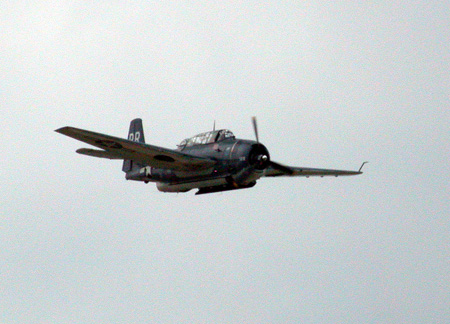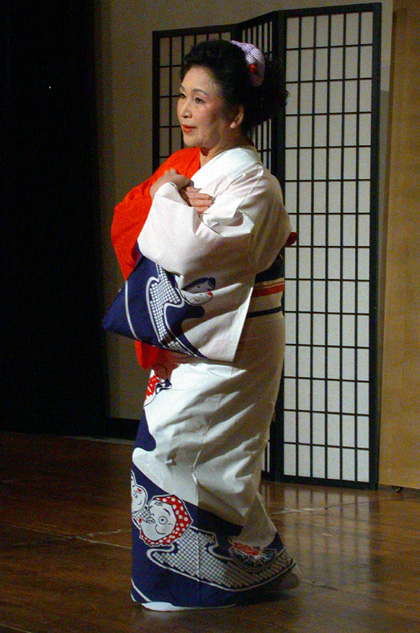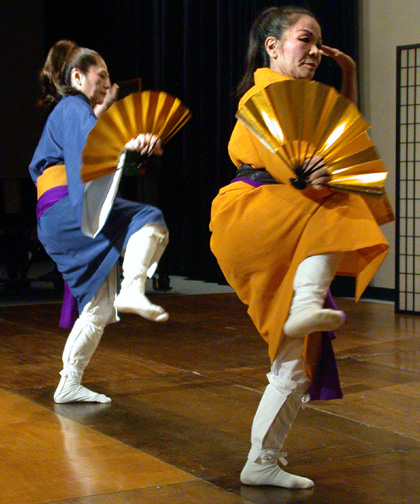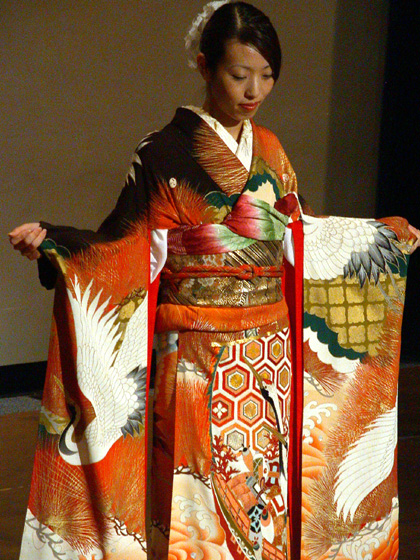Normally I don’t attend festivals with lots of people about, but I made exceptions for two events this weekend: the St. Louis Air Show and the Japanese Festival. The weather was wet and stormy, but held off raining for the most part. However, it was very hot, very humid, and there was little breeze.
I attended the Air Show and county fair on Saturday, surprised at how few people were there for the big mid-day show. I was able to find a place next to the fence easily and pick off some pictures, difficult because the sky was a blinding cloud white for the most part.

This was a more modern show with planes from World War II and Vietnam, as well as modern stunt planes and jets. There was, at different times, an F16 and an F18 flying about but I couldn’t get a good photograph, they moved so quickly. And loudly, too.
The show ran several World War II planes at the same time to show how they would work together. A B32 bomber (I think it was a B32, I’m not that familiar with planes) was flying about with a P51 “little buddy” beside it, making an interesting Mutt and Jeff appearance. The bomber didn’t see action in the war, as it rolled off the line the day after the war ended. However, a TBM-3 “Avenger”, also flying, did see action in the last weeks of the war. Over Japan as a matter of fact.

According to the sign next to the plane during the static display after the show, the VT88 had the following combat history:
July 18: Attacked Battleship Nagato, Yokosuka Naval Base
July 24: In the morning, Kure Naval Base, targets at Nishinoni Shima Ships: Haruna, Ise, Hyuga, Tone, and Oyodo. In the afternoon: Kure Naval Base, dropped frag bombs on the Haruna
July 25: Attack SW coast Honshu
July 28: Kure Naval Base. Ships: Haruna and Settsu. Aircraft took anti-aircraft damage through engine.
July 30: North shore of Honshu, Targets: Tsuruga seaport on sea of Japan. Hit freighter, factory, and RR.
August 10: Iwaki Airfiend, West coast of Sendai Koriyama, Bombed town of Koriyama
August 13: Target: Tokyo Shibaura Electric Plant, Bombed small ships SW of Yakosuka
August 15: Target: Tokyo Shibaura Electric Plant Called back – Japan Surrender
I was surprised at the number of air attacks directly against Japan at the time. Combined with the atomic bombs, the firebombs, and all the other bombing, we damn near bombed that country into the stone age.
I was thinking about this yesterday – how not? – when I went to Japanese Festival. The differences between the two festivals was like the difference between walking in down town New York during rush hour and a gentle stroll through a garden.
Sunday morning I watched a Japanese street entertainer, Mesaji Terasaw, known as the “Candyman” as he delighted audiences with his magic and his humor. He spun dragons out of candy, which he would give to the people as part of the show, having each do something different with their sticks, such as weaving them up and down. One woman, he put a lit stick of incense in her candy, and she thought it was a firecracker at first. The Candyman laughed, she laughed, everyone laughed.

After walking around a bit I decided to watch the Tazan Ryu/Okinawa Deigo Kai dancing in the main auditorium. The local St Louis Japan Society had brought in a special performer to dance for the audience, an older woman who had performed for years. As I watched her and the other performers, all with their heavy stage makeup, I was struck with how each performer’s movements became more graceful, and sure, as the performer’s age and experience increased.

I noticed a celebration of beauty in older women throughout the festival, and don’t know if this because the Society members are older, or if this is a part of the Japanese culture. If it is, I’d like to visit there someday. How refreshing to see the label beauty applied to someone who isn’t 21 and taut as a drum. Unfortunately, along with a celebration of age, there also seems to be a celebration of height, too, because I don’t think any of the women came up past my breasts in height. If I did visit, I think I would be horribly conspicuous.

After the dancing, I walked about a bit more and then wondered over where an ice carving demonstration was going to occur. Several people were standing about and I stood next to one person in front of a long reflecting pool. As the assistant to the ice carver was getting suggestions from the audience for subjects, the people to the right of me starting sitting down on the sidewalk and I heard a man yell at me “Sit down! You’re in our way!” I looked behind me in confusion because there was no one behind me, and then over into the face of a man about 50, white, and angry, you never saw such anger.
I started to explain that I couldn’t sit down on the ground because of problems with my knee and back, but he shoo’d me away with agitated movements and I could see there were people to the side of the pool who were sitting down on the pool edge. I started making my way through the crowd to the side and a lady about my age, tight lipped with anger said, “You were here first. You didn’t put yourself in anyone’s way. You should stay.”
Instead of ice carving, I went to watch the Omikoshi procession, first checking carefully to make sure no one was behind me.

Finding places to stand and take photos was a problem with both events. Saturday, the early evening air show focused on military planes and featured the Harrier Jet and an F18 flying about the airport. It also featured something new, something I hadn’t heard of before – a recreation of a ‘typical’ Vietnamese air support and strike against the Viet Cong.
As I was walking through the area I’d been in the for the earlier show, I noticed that more people were seated on hay bales drawn up to the fence. I started walking about trying to find a place to stand, stopped every once in a while to watch the preparations. About 20 minutes before show starting, I stopped in one place to take a photo of the ‘Cong’, when I heard a guy yell at me to move, I was in their way for the show. I looked down into face of a guy about 40, white, long haired. Angry.
I started walking around, stopping every few minutes looking for a spot, and same reaction from the men in the audience – yells, snide comments, mean things, all from men in their 40’s and 50’s, all white, all with the same angry eyes as if me standing in front of them, even for a moment, was an invasion of their territory. What was more puzzling is I was moving, I was trying to find a place to stand, and the show hadn’t started yet.
I was, frankly, deeply embarrassed, trying to walk where I wouldn’t incur someone’s wrath, wondering if I should just leave. Luckily, in the corner of a fence, a couple of people waved to me – it was a group of people like myself, people standing up who wanted to take photographs. I quietly thanked the couple who had been the ones who waved me over. They were both unsmiling, looking at the crowd behind me. She was about my age, maybe a bit older, and I could see she didn’t want to be there.
At that time the show started and several Vietnam era planes and helicopters took off into the air, and it was interesting watching them, but the action was on the ground as several ersatz Cong moved towards machine guns. They started firing at the planes, with very realistic sounds of battle and gun fire. One man towards the fence turned around and walked away, just as one of the planes overhead dropped a ‘bomb’, with ground effects and accompanying explosive force strong enough to send a shock wave into the crowd.
I noticed that all of the men who had yelled at me had their children standing on their little bales of hay to better see the action, as one by one, the Viet Cong were ’shot’ and ‘killed’, and the US marines, the good guys, moved in.

Behind me, late comers had arrived, dragging their bale of hay behind them – two men with one boy. One of the men grumbled to the others about us standing up and he didn’t know why we all just couldn’t sit down. I noticed that he was also wearing the same type of bandana that the League of the South men sometimes wear.
The show continued with much explosion and swooping down of helicopters, including a medivac come to haul off two men ‘injured’ during the warfare – all of the Cong being dead by that time.

As soon as the re-enactment was over, during the Color Guard, I made my way up the side of the fence and left the air show.
I tried not to let the angry man at the Japanese Festival ruin it for me. After the Omikoshi procession, I sat for a time in the rose garden, and then went to see the Kimono fashion show. The colors of the kimonos were wonderous, and many of them had been handed down through more than one generation – one kimono was over 75 years old if I heard correctly. I found it calming, and how can one not be carried away by the beauty of the outfits?

During the show, a demonstration was given of putting on a kimono – an operation that took two women in addition to the one being dressed. As they tied on I think it was the fourth, or perhaps, fifth sash, the demonstrator turned to the audience and said that if we ever had an idea that kimonos were comfortable, think again.
Things happen at a show of this nature – a mike failing, music CD gone missing, and a tiny little girl in an exquisite kimono, taking one look at the crowd, screaming in terror and bolting the stage. The woman who was providing descriptions didn’t allow any of it to phase her, and with a sharp sense of humor, kept everything going, smoothing over the bumps.

There was a beauty at the air show that matched the beauty of the Japanese art – the grace and skill of the pilots, especially the acrobatic flying was extraordinary to watch. The show in the morning was a delight because the focus was on 100 years of flight and the joy of flying.
And there was a Wing Walker – now, everyone loves a Wing Walker.

I munched on homemade potato chips and roasted corn at the air show, but late in the afternoon at the Festival I lunched on delicate Japanese pancakes and green tea ice cream.
The ending of the Japanese Festival for me was much quieter than the air show. I attended a Noh play, but rather than traditional Japanese Noh, this was modern Noh, a play called Lady Aoi, adapted from Tales of the Genji by Yukio Mishima. Some of the audience was disappointed not to see the traditional Noh, but the director of the play had a fascinating tale to tell of it, of the tradition, and of the playwright and famous author, Mishima. I was also able to chat briefly with the one of the main actresses afterwards, and found out that St. Louis is the only place in North America that is currently exploring Mishima’s works, a sign of surprisingly close ties between the city and Japan.
Oh, and following the Noh play – they showed the anime film, Spirited Away, and it was every bit as good as has been suggested.
As we were waiting for it to start, I heard people talking behind me about the movie, one asking the others what an-i-me was? A cartoon they were answered and they debated, loudly, about staying for the film. I found myself tensing, growing uncomfortable and thinking I should find a different place to sit. However, after 15 minutes of back and forth, they left to get food. During the movie, the seats stayed empty behind me.













